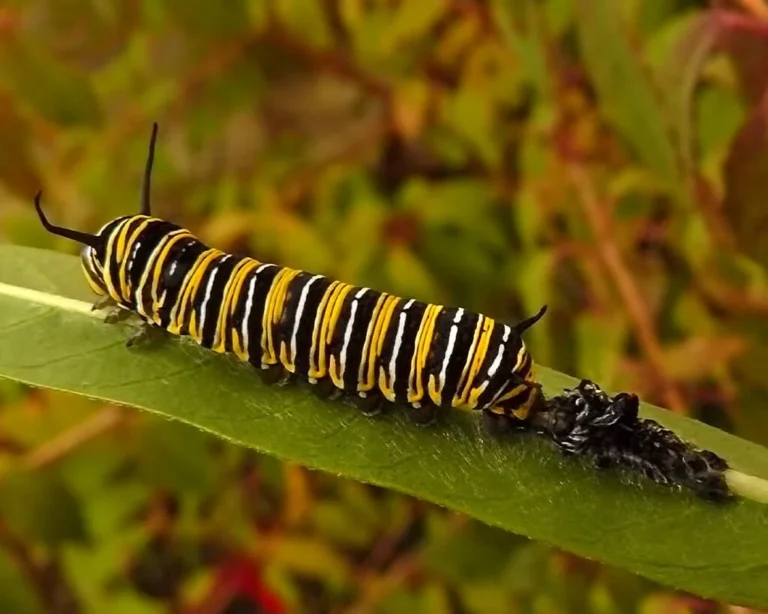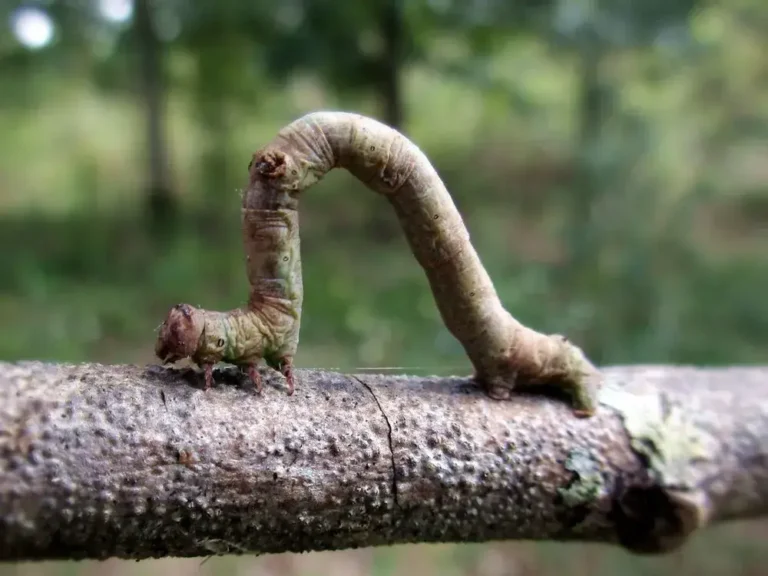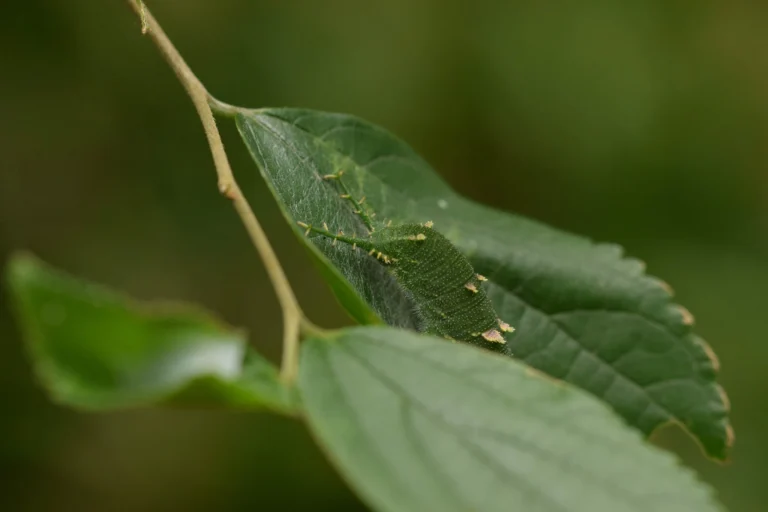White Caterpillar Explained: Species, Features & Poisonous Signs
Caterpillars, the baby version of butterflies, have always intrigued people, young and old alike. Imagine stumbling upon a white caterpillar during your morning walk.
Your mind might buzz with questions. What is this tiny creature? Could it be poisonous? Let’s explore the wonderful world of white caterpillars and answer some of these burning questions.
In this guide, we’ll talk about various types of white caterpillars, unravel the facts behind their poisonous nature, and dig into some fascinating myths and lore surrounding them. Let’s set on this journey to know everything about these tiny, fascinating creatures!
Table of Contents
Identifying White Caterpillars
Discovering a white caterpillar in your garden or during a nature walk can be a delightful experience. But, have you ever wondered what kind of white caterpillar you’ve found? Let’s learn how to identify them in this section.
White Fuzzy Caterpillar
Spotting a white fuzzy caterpillar is quite a sight! These caterpillars are covered in tiny hairs that give them a fluffy appearance. If you’re curious about identifying various types of white fuzzy caterpillars, paying attention to their unique features, such as the pattern of their hairs and the presence of spikes, can be quite helpful.
White Hairless Caterpillar (Unique Features)
Not all white caterpillars are fuzzy. Some are hairless, presenting a sleek and smooth appearance. These caterpillars might have other distinctive features like black spots or stripes. Observing them closely will help you identify the species they belong to.
White-lined Sphinx Caterpillar Stages (Metamorphosis)
A notable type of white caterpillar is the white-lined sphinx caterpillar. This fascinating species undergoes various stages of transformation before turning into a stunning moth. They often have noticeable stripes, making them easy to identify.
Regional Sightings
White caterpillars can be found in different regions including Florida, Texas, Ohio, and New York. Each region hosts a unique set of white caterpillar species. Depending on where you are, you might encounter different kinds of these fascinating creatures.
Visual Guide
Understanding that the world of white caterpillars is incredibly diverse and that it can be challenging to cover every type in one guide, it’s beneficial to refer to an extensive visual guide to aid in identification.
Such guides offer detailed pictures and descriptions to help you pinpoint the exact type of caterpillar you have encountered.
To further assist you in this process, we recommend visiting Discover Life’s comprehensive caterpillar guide. This platform serves as an abundant resource, providing imagery and insights into various caterpillar species, facilitating a smoother identification process.
Feel free to explore this platform to enhance your knowledge and become proficient in identifying different types of white caterpillars.
Common Questions
What is a white caterpillar with black spikes?
A white caterpillar adorned with black spikes usually belongs to the tussock moth family. The spikes are actually hairs that protect them from predators.
What does a white fuzzy caterpillar turn into?
A white fuzzy caterpillar metamorphoses into a moth, often characterized by a beautiful and intricate wing pattern. To know more about their transformation journey, explore how long a caterpillar stays in a cocoon.
Types of White Caterpillars
White caterpillars, while all sharing a primary color, are incredibly diverse in terms of features and characteristics. Let’s get to know some of the popular types that you might encounter.
White Fluffy Caterpillar
The white fluffy caterpillar, often found in regions like Texas and Florida, is known for its striking appearance. Its fluffy, hair-like setae make it quite distinctive. But, be cautious, as some species might have irritating hairs that can cause skin rashes.
White Hickory Tussock Moth Caterpillar
A native to North America, this caterpillar is easily identifiable with its white body and beautiful black markings. It’s essential to handle them with care, as their hair can cause irritation.
Cabbage White Caterpillar
This is a commonly found garden visitor, especially in regions where cabbages are grown. These caterpillars have smooth bodies, often with a greenish tinge, helping them to camouflage amidst the cabbage leaves.
White Marked Tussock Moth Caterpillar
This type is quite a sight with its vibrant combination of white, yellow, and black colors. While they are beautiful to look at, touching them is not advised due to their stinging hairs.
You might be curious to know more about how to manage them, for that, you can read how to get rid of white-marked tussock moth caterpillar.
White Woolly Bear Caterpillar
A less common sight, the white woolly bear caterpillar, is fascinating due to its fuzzy white hairs, which give it a bear-like appearance. Observing them from a distance is a safe bet to avoid any skin irritation.
Black and White Caterpillar Varieties
A less common sight, the white woolly bear caterpillar, is fascinating due to its fuzzy white hairs, which give it a bear-like appearance. Observing them from a distance is a safe bet to avoid any skin irritation.
In addition to the all-white varieties, you may also encounter caterpillars that showcase a striking combination of black and white colors. These caterpillars often have distinctive patterns, making them visually captivating.
Answers to Your Questions
What is a white caterpillar with a redhead?
A white caterpillar with a redhead often belongs to the family of tussock moths. The redhead is a distinctive feature that helps in identifying this particular species.
What does a white woolly caterpillar mean?
The sighting of a white woolly caterpillar is often associated with folklore and tales. In some cultures, it is believed to be a sign of good weather or a prosperous season ahead.
Are White Caterpillars Poisonous? Discovering the Truth
Often when we see something unusual, our minds are flooded with questions. White caterpillars, with their intriguing appearance, often spark curiosity. Are they poisonous? This is a common question that many people have. Let’s explore the truth behind this query.
Understanding Caterpillar Poisoning
Before we delve deep, it’s important to understand what we mean by ‘poisonous’. In the case of caterpillars, being poisonous generally refers to the presence of toxins in their hairs or spines, which can cause skin irritations or allergic reactions.
The Role of Hair and Spikes
Many white caterpillars have hairs or spikes which contain toxins. These are primarily defensive mechanisms to protect them from predators. When you touch them, these toxins can cause skin rashes or irritation.
It’s a good practice to avoid touching caterpillars with noticeable hairs or spikes to prevent any adverse reactions.
Recognizing Irritating Species
Certain species like the white-marked tussock moth caterpillar and the white hickory tussock moth caterpillar are known for causing skin irritation. Recognizing these species and avoiding direct contact can save you from unpleasant experiences.
Handling Caterpillars Safely
If you’re curious and wish to explore the world of caterpillars, it’s best to do so safely. You can use gloves to handle them or observe them from a safe distance. Teaching children about safe handling is equally important to foster their curiosity while keeping them safe.
What To Do In Case Of Skin Irritation
In case you accidentally come into contact with a caterpillar causing skin irritation, washing the affected area with soap and water is the first step. If the irritation persists, consulting with a healthcare provider is advisable.
Things Often Wondered
What happens if you touch a white caterpillar?
The white-lined sphinx caterpillar is not considered poisonous. However, like with any caterpillar, it’s always best to handle them with care to avoid any potential skin irritation.
What happens if you touch a white caterpillar?
Touching a white caterpillar, especially the ones with hairs or spikes, can cause skin irritation or rashes. It is always recommended to observe them without making direct contact to avoid any possible adverse reactions.
Myths and Fascinating Facts: The World of White Caterpillars
White caterpillars are not just about their beautiful and sometimes fuzzy appearance. They carry a world of stories, myths, and fascinating facts with them. In this section, we’ll look into some of these fascinating snippets that make these creatures even more intriguing.
Caterpillar Folklore
Across various cultures, the appearance of white caterpillars has been linked with different kinds of folklore. Some associate their sighting with good luck, while others consider them a sign of a harsh winter ahead.
It’s interesting to see how different communities interpret their appearance differently.
Metamorphosis Magic
One of the most wonderful things about caterpillars is their ability to transform into beautiful butterflies or moths. This remarkable change is known as metamorphosis. It’s a magical process that showcases the beauty and wonder of nature at its finest.
A Caterpillar’s Diet
White caterpillars, just like their colorful counterparts, have a voracious appetite. They mostly feed on plant leaves, with some species having a preference for specific plants. Understanding their diet can help in identifying them and in some cases controlling their population in gardens.
Caterpillar’s Role in the Ecosystem
Caterpillars play a vital role in the ecosystem. They are a food source for many predators like birds and insects. Their role in the food chain helps in maintaining a balance in the environment.
Safe Handling and Observation Tips
If you are a nature enthusiast and love observing these creatures, remember to do so safely. Using a stick to gently move them or wearing gloves can be good practices to adopt. It ensures both your safety and the well-being of the caterpillar.
Quick FAQs
What does a white caterpillar turn into?
White caterpillars turn into moths or butterflies. The species of the butterfly or moth depends on the specific type of caterpillar.
Why is my caterpillar turning white?
If a caterpillar is turning white, it could be a sign of a fungal infection or other illness. It is advisable to observe it from a distance and not to handle it to prevent the spread of possible diseases.
Your Guide to Identifying White Caterpillars
White caterpillars come in various species, each distinct and unique in its own way. Being able to identify them correctly can enhance your natural explorations significantly. Here, we offer you a guide to identifying different types of white caterpillars.
Identifying by Physical Features
Different species of white caterpillars can be identified through their physical features. Pay attention to aspects like the pattern of hair, the presence of spikes, and other distinctive markings. Some caterpillars have black spikes or a line of black spots, which can be a clear indicator of their species.
Habitats and Geographic Locations
The habitat and geographic location can be another cue for identification. For instance, the white fuzzy caterpillar in Texas may be different from the species found in Florida. Understanding their native habitats can give you insights into their behaviors and characteristics.
Seasonal Appearances
Certain caterpillars make their appearance in specific seasons. Keeping an eye on the seasonal patterns can help in identifying them correctly. For instance, the cabbage white caterpillar is often seen during the spring and summer months.
Community Forums and Groups
Joining community forums or groups where enthusiasts share their observations can be a wonderful resource. You can learn from others’ experiences and even share your own findings to contribute to the community knowledge base.
Curious Questions
How to identify a poisonous white fuzzy caterpillar?
Identifying a poisonous caterpillar often involves looking for warning signs like bright colors, hairs, or spikes. If you suspect a caterpillar is poisonous, it’s best to avoid direct contact and refer to identification guides for more information.
What is a white caterpillar with black spikes?
It could be a species like the Hickory Tussock Moth caterpillar. They are known for their distinctive appearance with white hairs and black spikes, which are a warning of their irritating hairs.
Behaviors and Habits: Getting to Know White Caterpillars Better
The world of white caterpillars is full of interesting behaviors and habits. In this section, we’ll delve into the little-known facts about their daily activities and routines that make these creatures so captivating.
Eating Habits
White caterpillars are known for their insatiable appetite. They mostly feed on leaves and plants, munching away tirelessly. Their eating habits are indeed a sight to behold as they can consume a large amount of foliage in a relatively short period.
Movement Patterns
Observing the movement patterns of these caterpillars can be quite fascinating. They move in a wave-like motion, contracting and extending their bodies to propel forward. This unique way of movement is not only mesmerizing to watch but is also efficient in helping them traverse various terrains.
Defensive Mechanisms
White caterpillars have developed various defensive mechanisms to protect themselves from predators. Some have urticating hairs that can cause irritation if touched, while others might exhibit startling behaviors to scare away potential threats. Learning about these defenses can give you a new appreciation for these creatures.
Social Behavior
Interestingly, some species of caterpillars exhibit social behaviors. They can be found living in groups and even moving together in a processional manner. These social interactions are a testament to the complex and interesting life of caterpillars.
Camouflage and Mimicry
Many white caterpillars employ the strategies of camouflage and mimicry to avoid being detected by predators. They can blend seamlessly into their surroundings or mimic the appearance of other creatures or objects to go unnoticed.
Quick FAQs
What does it mean when you see a white caterpillar?
It can be considered a sign of good luck in some cultures. Scientifically, it might indicate the presence of a particular species of butterflies or moths in the area, depending on the specific type of white caterpillar observed.
What happens if you touch a white caterpillar?
Touching a white caterpillar, especially one with hairs or spikes, can sometimes cause irritation or an allergic reaction. It’s always better to observe them from a distance to avoid any unwanted skin reactions.
The Life Cycle: Understanding the Stages of White Caterpillar
The journey of a caterpillar from an egg to a magnificent butterfly or moth is a captivating process. Here, we dissect each stage of their lifecycle to give you a comprehensive understanding of their growth and transformation.
The Egg Stage
These little creatures start their life as tiny eggs, often laid on the leaves of host plants. During this stage, they are extremely vulnerable and depend entirely on the environment for their survival. Observing the eggs, you might notice that they are minute and can be white, yellow, or even green.
The Larva Stage
This is the stage where we see the caterpillar in its most recognizable form. In this stage, the caterpillar grows rapidly, munching continuously on leaves to gain energy. The larva stage is where they develop their distinctive features, such as hairs, spikes, or unique patterns.
The Pupa Stage
After a period of incessant eating, the caterpillar finds a quiet place to transform into a pupa. This stage is characterized by significant transformation where the caterpillar rearranges its body structure to form a pupa, preparing to morph into a butterfly or moth. During this time, they might appear stationary, but a lot of changes are happening inside.
The Adult Stage
This is the final stage of their lifecycle. After spending time in the pupa, the transformed adult emerges, showcasing beautiful wings and a new body structure. It is now ready to start the cycle all over again, with females laying eggs to give birth to a new generation of caterpillars.
Quick FAQ
Why is my caterpillar turning white?
If a caterpillar is turning white, it could be a sign of a fungal infection or other illness. It is advisable to observe it from a distance and not to handle it to prevent the spread of possible diseases.
Symbolism: The Deeper Meaning Behind White Caterpillars
In various cultures and philosophies, white caterpillars, much like other creatures of nature, have been attributed with symbolic meanings that go beyond their physical existence. In this section, we aim to explore these underlying themes and what the sighting of a white caterpillar can symbolize.
Transformation and Growth
Just like their own life cycle, white caterpillars symbolize transformation and personal growth. Their journey from a caterpillar to a butterfly or a moth is a vivid representation of evolution and change, inspiring individuals to embrace the changes in their own lives with grace and poise.
Purity and Innocence
The white hue of these caterpillars is often associated with purity and innocence. Their presence in your garden can be seen as a gentle reminder to retain the purity of thoughts and actions in daily life.
Connection with Nature
White caterpillars serve as a bridge connecting humans with the intricate web of nature. Observing them closely can be a meditative experience, allowing individuals to feel more grounded and connected to the natural world.
Luck and Fortune
In some cultures, encountering a white caterpillar is considered a sign of good luck and fortune. It is believed to bring positivity and blessings to the individual who sees it.
Spiritual Awakening
For those on a spiritual path, the sighting of a white caterpillar can be seen as an indication of spiritual awakening. Their transformative journey encourages individuals to seek deeper meanings in life and pursue spiritual growth.
Taking Care of White Caterpillars: A Beginner’s Guide
Finding a white caterpillar can be an exciting experience. If you decide to take care of one, it’s crucial to provide the appropriate environment and nutrients for its growth and transformation.
In this section, we will explore the basic guidelines that one should follow to ensure the healthy development of a white caterpillar.
1. Creating the Right Habitat
- Enclosure: Choose a well-ventilated enclosure that allows the caterpillar to move freely.
- Temperature: Maintain a temperature that closely mimics their natural habitat.
- Plants: Add plants that are native to the caterpillar’s habitat, providing them with a familiar environment.
Feeding the White Caterpillar
- Diet: Identify the specific plant species that the caterpillar feeds on and ensure a steady supply of fresh leaves.
- Water: Provide a shallow dish with water to help them stay hydrated.
Monitoring Growth and Development
- Observation: Regularly monitor the caterpillar’s growth and look out for any signs of distress or illness.
- Handling: Handle the caterpillar gently, if necessary, to prevent any injuries.
Preparation for Transformation
- Space: As the caterpillar approaches the pupal stage, ensure it has enough space to form its chrysalis or cocoon.
- Safety: Keep the enclosure safe from potential predators and disturbances during this sensitive phase.
Release
- Timing: Once the caterpillar transforms into a butterfly or a moth, choose the right time to release it back into the wild.
- Location: Find a suitable location that offers a safe and nurturing environment for the newly transformed insect.
Conclusion
White caterpillars, with their ethereal presence and remarkable lifecycle, hold a special place in the hearts of nature enthusiasts.
Through this comprehensive guide, we journeyed through the fascinating world of white caterpillars, examining their characteristics, habitat, and symbolic significance, and exploring the necessary steps to take care of them.
From understanding the varied species of white caterpillars to deciphering the deep symbolism associated with them, we ventured deep into their world, hoping to inspire readers to appreciate the beauty and complexity these creatures bring into our lives.
Furthermore, we delved into the pressing question: Are white caterpillars poisonous? While some species are harmless and can be handled with bare hands, others possess urticating hairs that can cause skin irritation. Therefore, it’s always best to exercise caution and handle them with care.
As we conclude this journey, we hope that readers are now equipped with a wealth of knowledge about white caterpillars, fostering a deeper connection with these fascinating creatures and possibly even venturing into caring for them.
Thank you for joining us on this educational adventure, where we unraveled the secrets of the captivating world of white caterpillars. May your encounters with these creatures be filled with wonder and awe.
Frequently Asked Questions:
White caterpillars intrigue many nature enthusiasts and gardeners alike. In this section, we are going to tackle some of the frequently asked questions about these magnificent creatures, providing comprehensive answers that are sure to satisfy your curiosity.
Are White Caterpillars Poisonous?
Yes and no. The level of toxicity can vary between different species of white caterpillars. While some may have stinging hairs or spikes that can cause skin irritation, others are perfectly harmless. It is always advised to handle them with care to avoid any unwanted reactions.
How to Identify White Caterpillars?
Identifying white caterpillars can be done by observing their physical characteristics such as the presence of hairs, spikes, or patterns on their body. A detailed guide on identifying these caterpillars can be found in our segment on ‘Physical Characteristics and Identification’ above.
What to Do if You Find a White Caterpillar in Your Garden?
If you find a white caterpillar in your garden, you can let it be as it might be a sign of a healthy ecosystem. However, if you notice that they are causing significant damage to your plants, you might want to gently relocate them to another area with plentiful food sources.
What Does It Mean to Dream About White Caterpillars?
Dreaming about white caterpillars can have various interpretations. In general, seeing a caterpillar in your dream might signify a period of transformation or growth in your life.
What is the Significance of Seeing a White Caterpillar?
Seeing a white caterpillar in real life can be considered a treat for nature enthusiasts. They signify the rich biodiversity of an area and are an important part of the ecosystem, playing a role in pollination and serving as a food source for many predators.
How to Get Rid of White Caterpillars if They Become a Nuisance?
In cases where white caterpillars become a nuisance, it might be necessary to take measures to control their population. Natural methods such as introducing predators or using neem oil can be effective ways to manage their numbers without using harmful chemicals.




